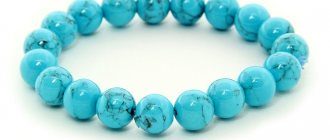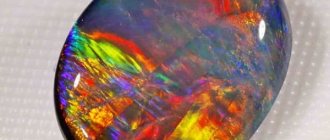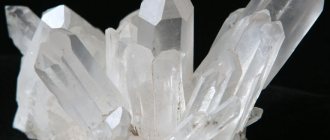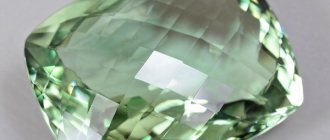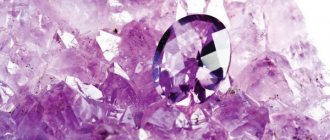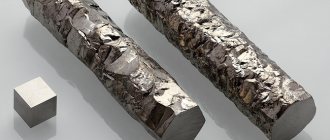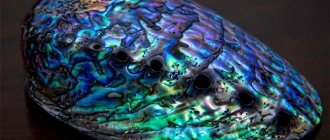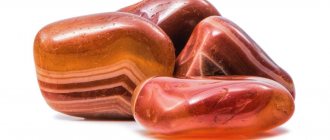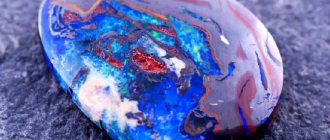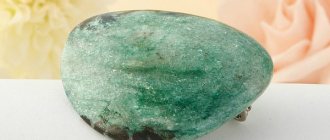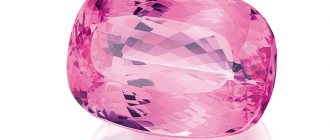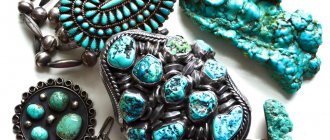But not only fashionistas love pink opal. The stone also has magical properties, as well as healing ones. So occultists, magicians, lithotherapists from all over the world are looking for delicate pink gems for their practices.
History and origin
The variety of opals is very large; in their natural assortment, these stones can compete with agate. Among them are precious ones, which are called noble opals and are valued only slightly below ruby, sapphire and emerald, and ordinary opals of different colors. They are used as ornamental stones.
Pink opal stone
Precious opals come in black and blue, as well as pink. But among “ignoble”, semi-precious and ornamental specimens, pink opals are also found. Their assignment to one class or another depends on the presence or absence of the opalescence effect - the play of color inside the stone.
Opalescence causes the appearance of pearlescent iridescence, the effect of internal glow, in some specimens - the effect of a kaleidoscope of translucent inclusions of different colors appearing and disappearing - red, yellow, green, silver...
Pink opal may or may not have an opalescence effect. Its price will depend on this: opalescent crystals are much more expensive. An ordinary pink stone has a delicate shade of morning dawn and is very beautiful in its own way.
Opals are found everywhere, and legends have been made about them everywhere. Indian legend claims that the body of the goddess Rainbow, who was pursued by men who desired her, was scattered into opals.
The word “opal” itself comes from the ancient Indian language of Sanskrit, where it sounded like “upala” and meant a precious stone in general.
The natives of Australia, known for its large reserves of these stones, believe that they appeared where the foot of the god who descended from heaven, the creator of the Universe, stepped.
Pink opal
The ancient Greeks believed that opals were the tears of the god Zeus, which fell from his eyes after the war with the Titans.
And an eerie Scandinavian legend says that a certain blacksmith forged these stones from the eyes of his children...
Pink opals stand a little apart. They come mainly from the territories of the former great Indian kingdoms of Central and South America - Mexico and Peru. Before the Spanish invasion, the stones were considered sacred by the founders of these states - the Aztecs and Incas. The Indians believed that the gods could look at the world through opals, but a person who looked at the stones could also see a deity. Therefore, they inserted pink opals into the eye sockets of the golden idols of the gods of their pantheon.
The Spaniards who captured these lands were not initially interested in opal. Gold idols were melted down into ingots, and “low-value” stones were simply picked out of the statues’ eye sockets. But at some point, pink stones came to Europe as a “related” product to gold, where they were immediately appreciated by fashionistas.
A belief arose and spread that pink opal helps maintain the purity and shine of blond hair.
Because Spain's nobility took great pride in their fair skin and blond hair—proof that their ancestors had not mixed with the Moors—pink opals became popular with fashionistas and fashionistas in the 16th century, gradually spreading throughout Europe.
Color varieties
Types of opal differ in shades. Let's consider noble precious and semi-precious opals.
Noble precious opals
The noble opal group includes all stones that create an opalescent effect. In addition to the main color, gems must shimmer in several shades.
Varieties of precious opal:
- Fiery. The gem palette includes all the colors of the rainbow.
- Black. The most expensive variety. Used in the jewelry industry. A purely black stone is not found, so the group combines dark blue and dark green gems.
- Girasol. Blue opal is characterized by purity and transparency.
- Harlequin. The surface of the gem resembles a mosaic, as all the triangles shimmer with multi-colored highlights, vaguely reminiscent of a harlequin costume. The stone is priceless.
- Royal stones. They got their name due to the combination of red in the middle and green around the edge, which resembles a royal robe.
Lechos, a sea-green stone, is also a noble stone
Simple semi-precious stones
This group is used for the manufacture of interior items and inexpensive jewelry.
Semi-precious minerals:
- hydrophane;
- cacholong;
- wax stones;
- chrysopal.
When purchasing semi-precious stones, it is advisable to consider the compatibility of the mineral with your zodiac sign.
Physicochemical characteristics
From a chemical point of view, this is a frozen hydrogel of silicon dioxide - quartz.
Opal is not a crystal, but an amorphous substance that always contains water.
Precious opals contain from 6 to 10% water, which can evaporate, causing the stone to lose its outer shine and even crack.
Pink opal bracelet
It is quite dense and heavy, but fragile substance. Hardness is average, up to 6.5 Mohs. The pink color is due to impurities of iron or manganese, or both.
Opalescent Peruvian opal is rare.
This mineral is insoluble in acids, but soluble in alkalis.
| Formula | SiO2 nH2O |
| Color | pink |
| Shine | Glassy, dim, sometimes pearlescent |
| Transparency | From transparent to translucent |
| Hardness | 5,5 — 6,5 |
| Cleavage | Absent |
| Kink | Conchoidal; fragile |
| Density | 1.96 - 2.20 g/cm³ |
Main characteristics of pink opal
If you look at pink opal from the point of view of geology and mineralogy, it represents a large fraction of red silica, which is “wedged” into the parent rock. Technically, the stone is not a crystal - it is an amorphous structure that consists of tiny globules, so the gem is very fragile. The raw rock appears as a round, oval or wedge-shaped conglomerate.
Pink opal is a semi-precious stone with magical and healing properties.
Pink stone is also called Andean or Peruvian opal. It is the most delicate, romantic, pastel variety of its family. With the exception of color, all its other properties coincide with its relative minerals:
- pearl, matte shimmer;
- full or partial transparency;
- absence of adhesions;
- softness and fragility due to the amorphous structure;
- vulnerability to alkalis, which can completely dissolve the gem.
According to jewelry classification, pink stone is considered semi-precious. Its cost is the same as that of its blue and black relatives. It is quite difficult to process; not every jeweler is ready to take on such a task.
Medicinal properties
Opals have a pronounced “masculine” projective yang energy, but their influence on the chakras and, accordingly, the possibilities of healing effects depend on the color.
Any opals are capable of:
- influence the nervous system, protecting against neuroses, anxiety and black melancholy;
- influence the pituitary gland and pineal gland, bring the body as a whole back to normal;
- serve as a prevention of infectious diseases.
Specific properties of pink opals:
- relief of pain in the stomach or intestines;
- restoration of the liver after destruction by alcohol (as part of complex therapy, with medications prescribed by a doctor);
- prevention of vision loss;
- treatment of headaches.
Bracelets with pink opal will relieve depression and speed up recovery in the postoperative period.
Pink opal bracelet
This stone also helps get rid of frequent fainting.
The loss of shine of a gem indicates an illness of its owner associated with increased sweating.
Magic properties
Pink opal is a stone of love and a faithful companion in matters of the heart for a girl.
Possessing strong “masculine” energy, it increases the attractiveness and sexuality of its owner in the eyes of men. A ring with an opal heals mental trauma after failure in love and makes it easier to cope with separation. And a gem placed on the table helps improve relationships with colleagues at work, household members, and children.
The magical properties that the stone possesses are revealed better if you wear it in silver. But the healing talisman will gain greater power in gold.
Price
The price of pink opal is determined depending on certain factors:
- the presence of precious metals in the frame;
- size and number of gems;
- other minerals in decoration.
Jewelry without an expensive frame can be purchased for prices ranging from 1,000 rubles to 3,000 rubles, depending on the number and nature of inclusions and the opalescence effect. Pink opals in gold or silver will cost 5,000–10,000 rubles.
Pink opal will be a good addition to your wardrobe, will help improve your personal life and give you self-confidence and strength. In return, you just need to be an honest person and take good care of your jewelry.
What outfit would you wear pink opal jewelry with? Tell us about your ideas in the comments below the article, share information on social networking pages.
Source
Zodiac compatibility
Due to its water content, opal is an absolutely “water” stone. It is optimally suited for Pisces, who often have excessive modesty, especially those who suffer from psychological complexes.
Earrings with pink opal
In principle, the mineral is suitable for people born under any zodiac sign, with the exception of those born in the year of the Fire Tiger or Water Snake - the stone will work the other way around, enhancing the negative traits of these people.
| Zodiac sign | Compatibility |
| Aries | — |
| Taurus | + |
| Twins | + |
| Cancer | + |
| a lion | — |
| Virgo | + |
| Scales | + |
| Scorpion | +++ |
| Sagittarius | + |
| Capricorn | + |
| Aquarius | + |
| Fish | +++ |
(“+++” – fits perfectly, “+” – can be worn, “-” – is strictly contraindicated)
Compatibility with other stones
Since pink opal, like all its fellows, belongs to the element of Water, it is optimally compatible with other “water” gems:
- topaz;
- emerald;
- pearls;
- alexandrite;
- moonstone;
- aquamarine;
- peridot.
Three-row bracelet made of pink opal, pearls and silver.
It can be worn with minerals that contain the properties of the Earth, as well as both elements at once - Earth and Water.
“Earth” stones include:
- chalcedony and agate;
- turquoise;
- malachite;
- Labrador;
- lapis lazuli;
- jade;
- jasper;
- rhodochrosite;
- morion.
Earrings with lapis lazuli and pink opal
Gems belonging to the elemental duet “Earth-Water” include:
- melanitis;
- aventurine;
- serpentine;
- tourmaline.
Earrings with tourmaline and pink opal
Opals are incompatible with Fire and Air crystals even more than other “water” minerals.
These are the antagonists. Pink opals should not be worn with diamond, ruby, garnets of all types, heliodor, heliolite, coral, pyrite, golden beryl and any type of quartz except morion.
Jewelry
Since each pink gem has a unique soft pink color, it does not need to be cut. The best way to process it is to sand it into an oval or round cabochon shape. Most often, these minerals are used as spectacular inserts into other jewelry. Precious metals in the form of gold or silver are ideal as a frame for it, which will highlight its delicacy and shine.
The luxury and sophistication of pink opal is especially evident when made into beads or a necklace. However, since we are talking about jewelry that does not include a metal frame, they should be worn carefully and, best of all, for various celebrations.
How to spot a fake
Synthetic pink opals are rare, but the mineral can be passed off as a glass or plastic imitation, or another pink stone of lesser value.
Natural opal is heavier than glass and plastic, as well as many other stones, due to its water content. Jewelry with it has a noticeable weight. In addition, its coloring is uneven, unlike the coloring of artificial imitations. Opalescent specimens play with multi-colored highlights, giving reflections to hands and surrounding objects in bright directional lighting.
Mineral deposits
Opals are mined all over the world, but the leader in production volumes is Australia (97%). Ethiopia comes in second.
This is interesting!
Opal is the national stone of Australia!
Small deposits of precious gems are located in Mexico and the USA, Brazil and Japan, Guatemala, Honduras and Slovakia. Opals are mined in very modest quantities in Russia and Ukraine.
As for ordinary opals, Mexico and Brazil, Turkey and Kazakhstan, Honduras and Guatemala are rich in their deposits.
This is interesting!
NASA announced in 2008 that opal deposits had been discovered on Mars.
How to wear and care
The gem does not like direct sunlight, excessive dryness or, on the contrary, humidity, since the water balance of the stone can change. When heated, water evaporates from the opal, but if you place it in an aqueous environment, it will “acquire” moisture, including excess.
Therefore, a product with this stone should not be worn on bare skin - it absorbs sweat. Don't wear it in hot and sunny weather when going for a long walk - it's an autumn stone. Protect from impacts, scratches and cracks as it is fragile.
Bracelet with pink opal and topaz
Should be stored in a separate soft bag. It is recommended to wash with plain water or mild acid-based household chemicals. Do not use soda for cleaning - it is an alkali that will quickly corrode the surface of the stone.
From time to time, “recharge” the stone by exposing it to moonlight.
Rules of care
The stone will demonstrate excellent compatibility with its owner if he follows the rules of caring for it:
- You should put on jewelry only after applying cosmetics, so as not to expose it to contamination; It is recommended to store it in a separate box. It is highly advisable to keep it separate from harder samples so as not to damage the fragile structure;
- The gem should not be exposed to constant temperature changes. In the winter season, it should be worn under clothing, without showing off;
- Do not allow the opal to remain in the sun for a long time. Ultraviolet light makes it cloudy and disrupts the integrity of the structure, drying out the water, so the mineral can crack and deform; protect the jewelry from mechanical influences, handle it carefully, without dropping it; rinse monthly under running water;
- Clean opals only with a mild soap solution, avoiding high concentrations of alkaline substances. It is best to prepare a solution from baby or laundry soap. If the jewelry is very dirty, it should be kept in the solution for 30 minutes, then rinsed with water and dried properly.
Remember that even with the most careful wearing and good care, opal will crack over time. Do not be upset about this: take the jewelry to an experienced jeweler, and he will polish the surface of the stones so that they will certainly shine with renewed vigor.
